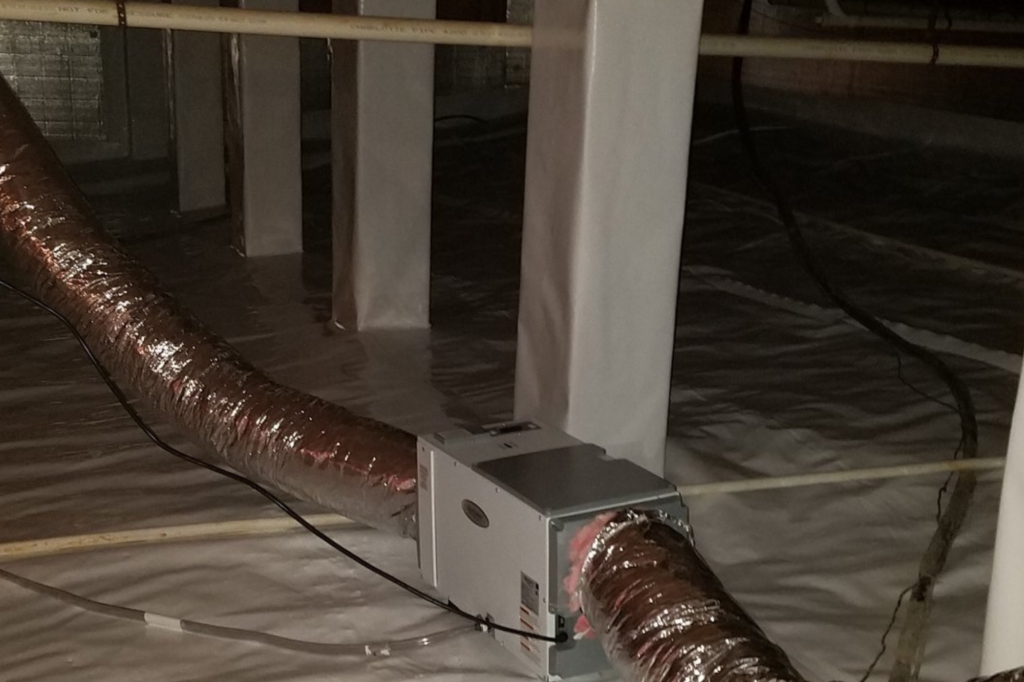Ignoring the hidden dangers of a damp crawl space in your home can instigate severe threats to both your abode and your health. Poor ventilation and leaks may create the perfect condition for mold and mildew, which will not only weaken your home’s wooden structures but also trigger allergies and respiratory problems. Additionally, elevated humidity, potentially increased by these damp conditions, can make existing health issues worse. Be aware that persistent dampness might even pave the way for harmful pests. If you explore further, you’re bound to discover more about the risks and master how to prevent such silent destruction with crawlspace encapsulation services.
Key Takeaways
- Damp crawl spaces can lead to structural damage, including weakened wooden structures and potential foundation instability.
- High moisture levels in crawl spaces can promote mold growth, accelerating the decay of wooden components.
- Health concerns from damp crawl spaces include allergies and respiratory issues triggered by mold spores and dust mites.
- Dampness can lead to radon gas accumulation, posing significant long-term health risks.
- Preventing dampness involves proper ventilation, moisture barriers, efficient drainage systems, and regular maintenance inspections.
Understanding Crawl Spaces
While many homeowners may dismiss crawl spaces as insignificant, understanding their role is crucial to maintaining your home’s structural integrity and the health of those who live in it. These shallow, unfinished areas beneath your home play host to your plumbing, electrical, and HVAC systems.
However, they’re also prone to dampness, which presents a host of dangers. Damp crawl spaces can become a breeding ground for mold and mildew. These fungi not only cause unpleasant odors but also lead to wood deterioration, compromising your home’s stability.
Additionally, damp crawl spaces can attract pests like termites, causing further structural damage. From a health perspective, a damp crawl space poses serious risks. Mold spores can trigger allergies, asthma, and respiratory infections.
Dampness in the crawl space can also increase indoor humidity, exacerbating existing health issues. Recognizing signs of moisture in your crawl space is essential. Look out for musty odors, visible mold, an increase in pests, soft floors, and excessive condensation on pipes. Crawlspace encapsulation is an effective solution to prevent these issues by sealing off moisture and improving air quality in your home.
The Causes of Dampness
Understanding the root causes of crawl space dampness is the first step in managing this issue effectively. A couple of factors can contribute to this problem.
Poor ventilation is a common culprit. Without adequate airflow, moisture can easily accumulate in your crawl space. This is often exacerbated by groundwater seepage, which can occur if the soil surrounding your home isn’t properly graded or drained.
Plumbing leaks are another cause of dampness. Even minor leaks can lead to significant moisture buildup over time.
Additionally, high humidity can play a role, especially in climates where the air is often moist. In these environments, it’s not uncommon for moisture to be drawn into the crawl space, resulting in dampness.
Structural Risks of Damp Spaces
Ignoring the dampness in your crawl space can lead to serious structural issues over time. Excess moisture weakens wooden structures, causing warping, softening, and even collapse. It’s like your home’s backbone slowly disintegrating, compromising the stability of your living space.
Damp conditions also encourage mold and mildew growth. They gnaw at the wooden components, accelerating their decay. The resulting unpleasant odors aren’t only a nuisance but an alarming sign of the ongoing deterioration beneath your floorboards.
But that’s not all. Persistent moisture in the crawl space can affect the very foundation of your home. It can cause soil shifting, leading to cracks and instability in your home’s foundational structure. This could result in uneven floors, cracks in your walls, or even worse, structural failure.
Pest infestations are another structural risk. Damp environments attract termites, carpenter ants, and rodents, which can cause damage to insulation, wiring, and wood structures. This could mean costly repairs in the future.
In short, a damp crawl space isn’t just an out-of-sight, out-of-mind issue. It’s a ticking time bomb that can cause significant damage to your home’s structural integrity.

Health Concerns From Dampness
Beyond the structural risks, it’s essential to evaluate the potential health implications of a damp crawl space. When left unchecked, this moisture-rich environment becomes a breeding ground for molds and mildew. These fungi release spores into the air, which, when inhaled, can trigger allergies, exacerbate asthma symptoms, and even cause respiratory infections.
Moreover, dampness can increase indoor humidity. You mightn’t realize it, but moisture from your crawl space can seep into your living areas, creating an uncomfortable environment. This can be particularly distressing if you or a family member have pre-existing respiratory conditions that are aggravated by high humidity.
Additionally, a damp crawl space can lead to the accumulation of radon gas, a silent and invisible carcinogen. Radon seepage into your home can pose significant long-term health risks, including lung cancer.
Finally, high humidity levels are known to encourage dust mite proliferation. These tiny critters are a common allergen and can worsen symptoms in individuals with allergies or asthma.
In essence, a damp crawl space isn’t just a structural issue; it’s a health hazard that requires your attention.
Prevention and Maintenance Strategies
While it’s essential to recognize the threats posed by a damp crawl space, it’s equally important to implement effective prevention and maintenance strategies. These measures not only safeguard your home’s structural integrity but also protect your health.
Firstly, establish proper ventilation and airflow in your crawl space. This can involve installing vents, fans, or even a dehumidifier to regulate moisture levels. You’d be surprised how much a good circulation system can prevent dampness and related problems.
Next, consider crawlspace encapsulation Richmond areas along with the use of vapor barriers. By sealing your crawl space with plastic sheeting and insulation, you’re effectively creating a moisture-proof barrier. This method can drastically reduce the amount of moisture seeping into your crawl space, protecting your home from mold, structural damage, and poor air quality..
In addition, addressing drainage and waterproofing is critical. This might involve installing sump pumps, French drains, or even grading your landscape to direct water away from your home’s foundation.
Lastly, incorporate routine inspections and maintenance into your home care regimen. Regularly check your crawl space for leaks, cracks, and signs of moisture damage.
Expert Solutions for Damp Crawl Spaces
Even if you’ve taken all the preventative steps, a persistently damp crawl space may require professional intervention. Experts in crawl space remediation can offer solutions tailored to your home’s unique needs.
They may suggest encapsulation, which involves sealing the crawl space with a vapor barrier to prevent moisture penetration. This method not only mitigates dampness but also improves your home’s energy efficiency.
Further, they could recommend installing a dehumidifier to control the humidity level or a sump pump to remove accumulated water. Both options prevent the conditions conducive to mold growth and wood rot.
If your house is in an area prone to water seepage, professionals might opt for exterior drainage systems, like French drains, to redirect water away from your home’s foundation.
Periodic inspections by professionals help identify potential problems early, allowing for timely interventions. Pest control measures can also be implemented to deter infestations attracted to damp environments.
By addressing the root causes of a damp crawl space, you’ll not only protect your home’s structural integrity but also guarantee a healthier living environment.
Don’t underestimate the value of expert solutions.
In Summary
Don’t underestimate the risks of a damp crawl space. It’s not just about property damage but also your health. Moisture buildup can lead to mold growth, structural damage, and even pest infestations. Prevention is key to maintaining a dry crawl space and getting professional help can guarantee effective solutions. Tiger C Construction specializes in crawl space waterproofing and moisture control, ensuring your home stays safe and healthy. Now that you’re aware take action—protect your home and your health from the hidden dangers lurking beneath your feet.
